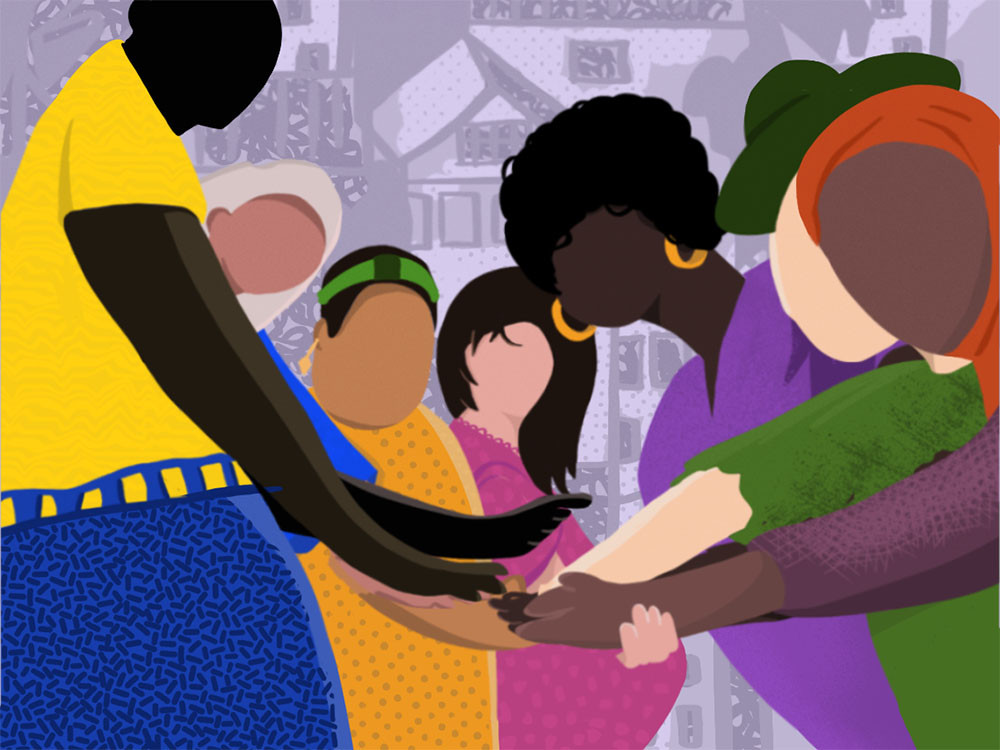 (Illustration by Raffi Marhaba, The Dream Creative)
(Illustration by Raffi Marhaba, The Dream Creative)
How should the philanthropic sector address rising rents and the severe lack of affordable housing across the United States—two primary forces that cause people to lose their homes?
About seven years ago I was tasked with developing a funding portfolio for the Melville Charitable Trust to figure out how we—a small funder—could make an outsized impact on the growing supply issue and its cascading effects on our lowest-income friends, neighbors, and family members.

I was a senior program officer with the trust at that point, and was new to philanthropy and fairly new to housing. With only a mustard seed of knowledge, and a lot of humility, I spent time reading and learning from others about leaders in the field, the latest funding approaches, gaps in funding, and who was funding what.
Although new to both housing and philanthropy, I knew that where and how we live is integral to our health, education, and economic mobility. And I knew that unstable, unaffordable, and unsafe housing meant families had to choose between rent and food, utilities, medicines, and childcare. With limited affordable rental options in better resourced areas, people are sometimes held hostage in rodent- and mold-infested homes, battling the health consequences of toxic climate and environmental conditions, and far away from medical care, transportation, jobs, and quality schools.
To learn how the trust could do more, I reached out to grantmakers who funded housing, and, more importantly, to funders that did not support housing specifically but whose work signaled that they understood that housing stability impacted the broader outcomes they were hoping to see.
Insights from those early conversations were clarifying. While funder colleagues understood the inextricable connection between stable housing and issues like increasing graduation rates among kids in low-income areas, reducing childhood asthma, or increasing family income, it became evident that philanthropy was not organized to address intersectional issues—even within the same foundation.
Despite the intersectional social and economic challenges we address, philanthropy is typically organized by siloed programmatic areas. We need to address major issues like housing and homelessness in ways that impact the overall well-being of the people living in low-wealth communities, particularly people of color. For the trust, we could have continued to focus solely on improving the crisis response system to reconnect people to housing, but we realized the problem we were trying to solve was much bigger than people losing their homes. The problem is bigger than any one issue.
What would happen if we leveraged the collective power of philanthropy to improve the lives of a specific group of people rather than improve outcomes within a specific program area?
That was the impetus for launching Funders for Housing and Opportunity (FHO), a diverse group of funders with varied funding priorities, but who all agreed that safe, stable housing was key to advancing outcomes in their respective program areas. The original cohort of foundations that helped develop FHO included the Annie E. Casey Foundation, Ford Foundation, Gates Foundation, Kresge Foundation, MacArthur Foundation, Oak Foundation, and Terwilliger Foundation. As Charles Rutheiser of the Annie E. Casey Foundation explains in the opening essay of this series, “No group or organization can create meaningful change alone.”
Space for Thinking, Trust-Building, and Engagement
From the outset, the trust was clear that we weren’t asking funders for money. We were asking them to come and help think about housing together, and if we were to form a collaborative what it would look like. That left space for people to engage without a commitment.
We engaged the help of PolicyLink to facilitate the process and a “kitchen cabinet” of thought partners comprised of the Urban Institute, National Housing Conference, and Hattaway Communications to lend their expertise.
We used the Results Count™ framework to bring discipline and structure to our conversations and to narrow our focus to 1) the specific target population we wanted to impact; and 2) the result we wanted to see for that population. Once we agreed on those two things (which was harder than it sounds!) we used those decisions to guide our thinking around the changes we wanted to see and the types of grants we could fund together that would contribute to those changes. Every decision would need to tie back to the population and the shared result or it was outside of scope. This discipline helped weed out strategies and funding opportunities that, although worthy of supporting, were not in service to the result we wanted.
It took two years for us to agree on a final framework. We only met quarterly but a lot of work was done. Each meeting was structured around a decision that brought us closer to a working model, and we also built in time for us to get to know each other. That last piece—building in time to share a meal and talk—was the most valuable because we came to trust one another and learn more about each other’s work and priorities. And as often happens when trust is developed, FHO members began to team up outside of our work and jointly fund or contribute to each other’s efforts.
At first, it was a challenge to get large institutions to think differently about their approach to grantmaking, and to think about who they were targeting with that funding. When first asked what population we would target, one large foundation staff member said, “We don’t fund populations!” even though the fruits of their work clearly impacted specific groups of people more than others. When we examined our respective grantmaking over two years, we found that we all had the same population in mind—people with low incomes, living in low-wealth and under-resourced communities, who were most often people of color.
We looked to data to help affirm that we were on the right path.
At the time of FHO’s founding, we examined which populations were paying more than 50 percent of their income on rent. Of those severely cost-burdened households, 2/3 had an annual income under $15K and a full 93 percent had annual incomes below $30K. We also found within severely cost-burdened households, 24 percent were Black and 20 percent were Latino/a/x, although each only represented 12.6 percent and 17.1 percent of the US population, respectively.
That examination of the data helped us settle on households that are severely cost burdened because those are the same households that have low and extremely low incomes, the same households that are more likely to be households of color, and the same households with disparate health, economic, and education outcomes that the various foundations were trying to improve.
Having agreed on what we wanted our funding to do and for whom, we turned to figuring out our funding priorities. This is no easy task when trying to move the needle on issues as complex as housing.
Drawing on their considerable work supporting the Housing as a Platform series produced by the Urban Institute, The MacArthur Foundation was especially helpful in guiding our development of a mutually reinforcing strategy comprised of three funding areas that work as an ecosystem: policy, advocacy, and organizing; narrative change; and elevating what works.
Impact on the Trust’s Funding Priorities
Along with guiding the work of our collective funding efforts, FHO’s focus on a mutually reinforcing strategy helped the trust reimagine our own grantmaking work and serves as a model for our new Grantmaking Strategy for Equitable Results. As with FHO, the trust employed the Results Count™ framework to provide the discipline needed to fine tune our grantmaking and get to the root causes of homelessness and housing instability.
We began by examining data to understand which populations are most impacted by unstable housing and homelessness. Then we dug into the root causes that perpetuate housing instability among these communities and which of many complex issues we could address, given our size and capacity. Basing our work on the theory of aligned contributions, the trust’s grantmaking now addresses the following root causes:
- Lack of rapid pathways to decent, permanent housing for people experiencing and at risk of homelessness;
- Insufficient income and assets that create housing instability and expand the racial wealth gap;
- Racist housing, zoning, and land-use policies that perpetuate housing instability and homelessness.
Like FHO, we use three mutually reinforcing strategies to deploy our funding—anti-racist policy change; building and shifting power of people with lived experience of unstable housing; and shifting public and political will.
In that regard, I see FHO as both a movement for systemic change within housing-oriented philanthropy and a learning lab. I learned an enormous amount from those early years as we built FHO and continue to learn from FHO to this day.
Good and Hard Lessons Learned
The most encouraging lesson from launching FHO is that foundations with varying programmatic priorities can collaborate on funding when we agree on who we’re trying to help and the result we want to see.
And as noted above, this was a long-term effort and required a lot of work and nudging to do things differently.
Philanthropy tends to defer to old mental models, thinking that if we can’t name a finite project with a beginning and end then we can’t support it. The beauty of funding through a collaborative allows funders to share the risk of taking the big bets we may not be able to fund on our own.
My greatest takeaway is the need to focus first on the population and the result, and then decide how we’ll get there, together, with multiple, complementary approaches that are rigorously examined and refined as needed.
Marion Wright Edelman used an unforgettable metaphor when speaking to a room of foundation executives about collaboration. She said, “Put the baby on the table. What does that baby need? You can’t say, ‘Well, I can’t help because I only fund arms’ or ‘I only fund feet.’” No! We need to come to the table each ready and willing to contribute according to our strengths and together we help that baby thrive.
What we tried to do with FHO, and are still working on, is to help philanthropy see housing as something that undergirds everything in our lives. It is the foundation for that baby to thrive. FHO’s north star is that renters have access to safe, stable homes they can afford in communities that support better health, economic mobility, and access to good jobs and schools, free from the barriers and harms of systemic racism. To me, that’s not a project—that's a whole new way to view grantmaking. As this series of essays has highlighted, we’ve made progress, but there is more to be done. As a sector, I believe we have not maximized our potential impact. But I am still hopeful.
Support SSIR’s coverage of cross-sector solutions to global challenges.
Help us further the reach of innovative ideas. Donate today.
Read more stories by Susan K. Thomas.

